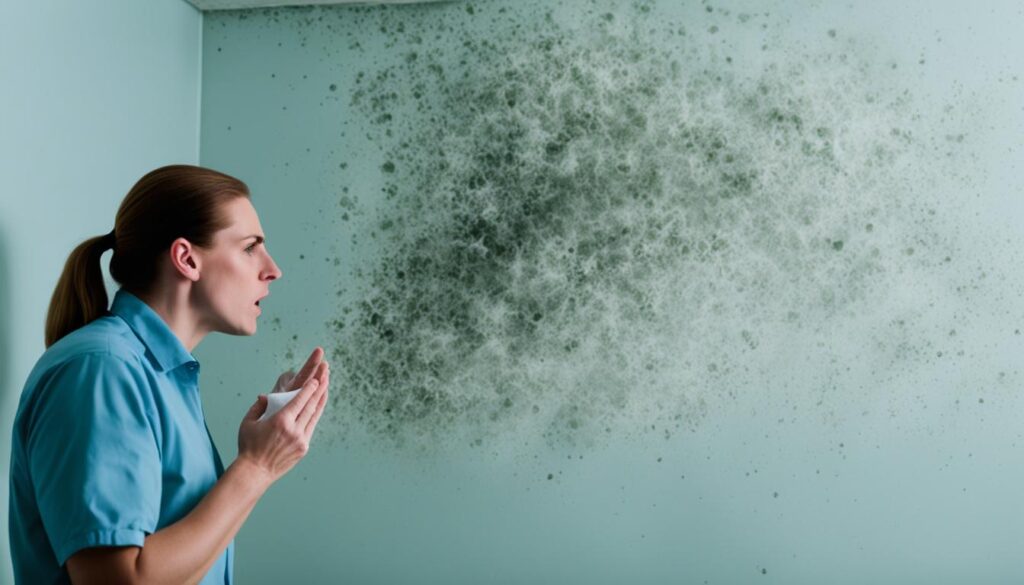
Understanding Mold Exposure Symptoms
Mold exposure can have serious implications on our health. The symptoms of mold exposure vary from person to person and can range from mild to severe. Identifying these symptoms is crucial for recognizing potential health issues caused by mold and taking the necessary steps to protect ourselves and our loved ones.
Key Takeaways:
- Recognizing the symptoms of mold exposure is essential for early detection and prevention of health issues.
- Mold exposure symptoms can include respiratory problems, allergic reactions, skin irritation, and more.
- Individual sensitivity to mold and the type and duration of exposure can influence the severity of symptoms.
- Seeking medical attention and addressing the underlying mold problem are important steps in managing mold exposure symptoms.
- Preventing mold growth in our living environment is key to minimizing the risk of mold-related health issues.
Common Symptoms of Mold Exposure
Taking prompt action in identifying and addressing mold exposure is crucial for maintaining a healthy living environment. By understanding the common symptoms associated with mold exposure, you can seek timely medical attention and take effective measures to address the underlying mold problem.
Mold exposure symptoms can vary depending on factors such as an individual’s sensitivity, the type of mold present, and the duration of exposure.
Here are some of the most common symptoms experienced by individuals exposed to mold:
- Coughing: Persistent coughing that isn’t related to a cold or other respiratory condition can be a sign of mold exposure. Mold spores can irritate the respiratory system, causing coughing spells.
- Sneezing and Nasal Congestion: If you find yourself constantly sneezing or experiencing nasal congestion while indoors, it may be due to mold exposure. Mold spores can trigger allergic reactions, leading to these symptoms.
- Watery Eyes: Mold exposure can cause your eyes to become red, itchy, and watery. If your eyes consistently feel irritated while inside your home or office, mold could be the culprit.
- Shortness of Breath: Difficulty breathing or feeling short of breath can occur when mold spores are inhaled. This symptom is particularly common in individuals with pre-existing respiratory conditions like asthma.
- Fatigue: Mold exposure can lead to unexplained fatigue and low energy levels. If you constantly feel tired despite getting enough rest, mold exposure could be a contributing factor.
- Headaches: Persistent or recurring headaches can be a manifestation of mold exposure. The presence of mold in your living environment can trigger headaches or make existing ones worse.
- Skin Irritation: Mold exposure may cause skin irritation, such as rashes, itchiness, or hives. If you notice unexplained skin problems that worsen while inside your home, mold could be the cause.
In addition to these symptoms, mold exposure can also exacerbate existing respiratory conditions, cause sinus infections, and contribute to the development or worsening of asthma.
If you experience any of these symptoms and suspect mold growth in your home, it’s important to consult a healthcare professional. Proper diagnosis and treatment are crucial for managing your symptoms and addressing the underlying mold issue.
“Recognizing the symptoms of mold exposure is the first step towards a healthier living environment.”
How to Deal with Mold Exposure Symptoms
If you suspect that mold exposure is causing your symptoms, here are some steps you can take:
- Consult a healthcare professional to get a proper diagnosis and treatment plan.
- Contact a professional mold assessment and remediation service to identify and eliminate the mold source.
- Improve ventilation in your home by opening windows or using exhaust fans in areas prone to high moisture, such as bathrooms and kitchens.
- Reduce indoor humidity levels by using dehumidifiers or addressing any plumbing or ventilation issues that may contribute to excess moisture.
- Clean and dry any areas affected by mold promptly, using appropriate cleaning agents and protective gear.
By taking these steps, you can not only alleviate your symptoms but also create a mold-free and healthier living environment for you and your loved ones.

Prevention Tips for Mold Exposure
To maintain a safer living environment and minimize your risk of mold exposure, it’s important to take proactive measures to address and prevent mold growth in your home. By following these tips, you can reduce the chances of experiencing the symptoms associated with mold exposure.
- Control humidity: Mold thrives in damp environments, so it’s essential to keep the humidity levels in your home below 50 percent. Use dehumidifiers in areas prone to moisture, such as basements and bathrooms, and fix any leaks or water seepage promptly.
- Ventilate properly: Good air circulation helps prevent moisture buildup. Make sure your kitchen, bathroom, and laundry areas are properly ventilated with exhaust fans that vent outside, and open windows regularly to let fresh air in.
- Monitor and address leaks: Regularly inspect your home for any signs of leaks, such as water stains, dripping pipes, or wet spots. Promptly repair any leaks to prevent moisture accumulation and the growth of mold.
- Use mold-resistant materials: When renovating or remodeling, choose mold-resistant materials for areas prone to moisture, such as bathrooms. Look for products labeled as mold-resistant, including drywall, insulation, and paint.
- Keep your home clean: Regularly clean and dust your home to prevent the buildup of dust and potential mold spores. Pay extra attention to areas with high moisture, such as bathrooms and kitchens.
- Properly maintain your HVAC system: Regularly clean and inspect your heating, ventilation, and air conditioning (HVAC) system to ensure it is functioning properly. Change filters as recommended by the manufacturer to reduce the risk of mold growth.
- Address water damage immediately: If your home experiences water damage, such as a flood or significant leak, address it immediately. Dry out affected areas within 24-48 hours to prevent mold growth.
By implementing these prevention tips, you can create a healthier living environment and reduce the likelihood of mold exposure. Remember, if you suspect mold growth in your home or experience persistent symptoms, it’s important to consult with a professional mold assessment and remediation service for a thorough evaluation and appropriate actions.

Conclusion
In conclusion, understanding the symptoms of mold exposure is crucial for maintaining a healthy living environment. By being aware of the common symptoms and taking preventive measures, you can minimize the risk of mold-related health issues.
If you suspect mold growth in your home, it is recommended to seek professional assistance for a thorough assessment and appropriate remedial actions. One such reliable service provider is Fix Mold Miami, who can be reached at 305-465-6653. Their team of experts is equipped to handle mold assessment and remediation, ensuring the creation of a mold-free living space for you and your loved ones.
Protect your health and take proactive steps to create a safer and healthier living environment by addressing and preventing mold growth. Remember, early detection and intervention are key to mitigating the potential risks associated with mold exposure.




